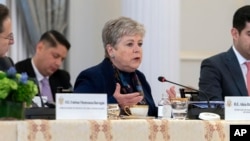U.S. Secretary of State Antony Blinken hosted a meeting Wednesday in Washington with top Mexican and Guatemalan officials to discuss managing irregular migration, displacement, and expanding lawful immigration pathways in the Western Hemisphere.
Blinken, joined by Secretary of Homeland Security Alejandro Mayorkas and other high-level U.S. officials, met with Guatemalan Foreign Affairs Minister Carlos Ramiro Martínez, Guatemalan Minister of the Interior Francisco José Jiménez Irungaray, and Mexican Foreign Affairs Secretary Alicia Bárcena Ibarra.
The three delegations agreed on the urgency of addressing the root causes of irregular migration, expanding more legal pathways to the U.S., and the creation of a U.S., Mexico, and Guatemala "operational cell" to jointly tackle migration issues.
“We are really here to double down on the collaboration that we have in dealing with migration flows. We know that all of us are living in what is genuinely a historic time. Around the world, more people are on the move than at any time in recorded history, and the same is true, of course, in our own hemisphere,” Blinken said.
Guatemala will also host the next Los Angeles Declaration on Migration and Protection ministerial meeting in April. Martínez said they do not see the migration issue as a problem, but a phenomenon.
“And we believe that behind this, of course, there is a fundamental task for the Guatemalan state. We are the first who must manage the needs of our population. We must create and provide opportunities so that our people do not migrate, so that these flows of Guatemalans seeking opportunities do not continue to grow. So, the first task is a task for the Guatemalan state,” Martinez said.
During a background call with reporters on Tuesday, a U.S. official said Mexican and Guatemalan nationals represent the largest number of migrants that border officers currently encounter at the Southwest border.
The official added that the United States is looking forward to deepening trilateral efforts to expand legal pathways, including for labor migration.
“One of our most successful lawful pathway initiatives — in 2023, we issued over 442,000 visas to temporary and seasonal workers. Those who work here through labor pathways contribute to the U.S. economy and send money back home to support friends and family and invest in their futures,” the U.S. official said.
Earlier this year, officials from the United States and Mexico met and set goals to make migration numbers consistent, fight human smuggling and create a plan to discourage migrants from crossing through the dangerous Darién Gap in Panama.
The meetings come as the Biden administration considers cracking down on asylum-seekers after a record number of migrants arrived at the U.S.-Mexico border in December. The number fell by 41% in January.
“The difficult paths that migrants in our continent take towards the North to seek better and more opportunities in life is transcendental. … These geographical circumstances mean that as countries, we face most of the cycles of the migration process. Guatemala and Mexico are origin, transit, destination and return,” Barcena said.
Immigration has become one of the leading issues in this year’s presidential election. Former President Donald Trump, who is likely to face President Joe Biden in November, promises to take stronger action on it.
For now, Biden is going to Brownsville, Texas, on Thursday. At the same time, Trump will be going to Eagle Pass, Texas, which is also on the border with Mexico.







